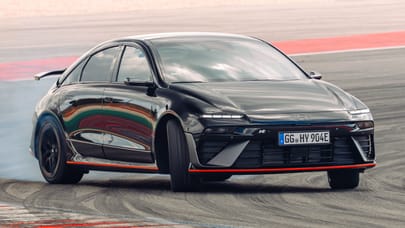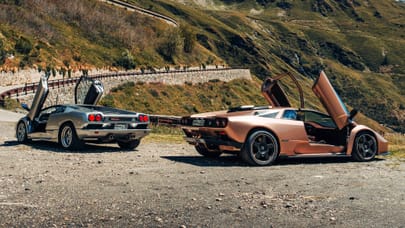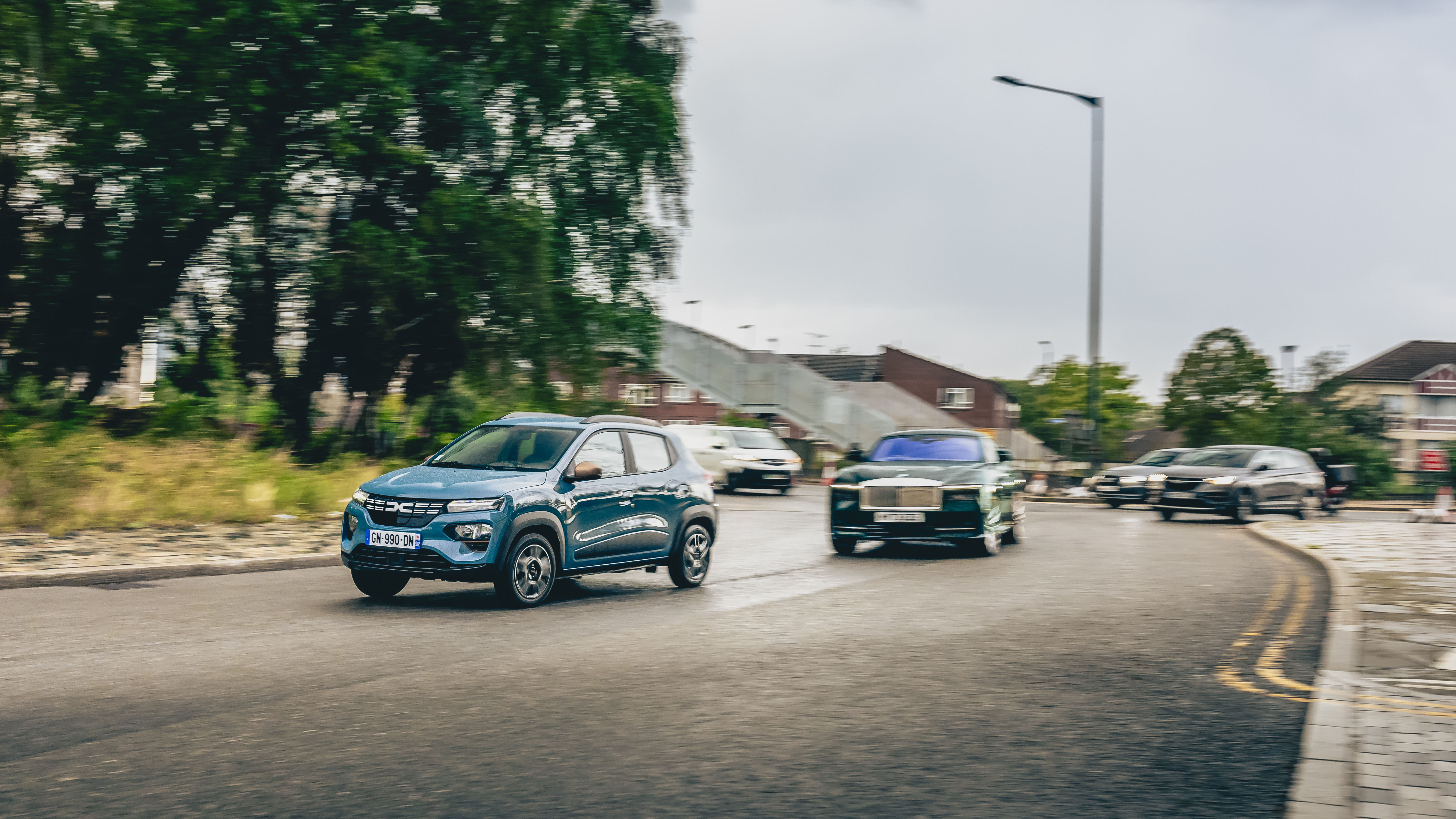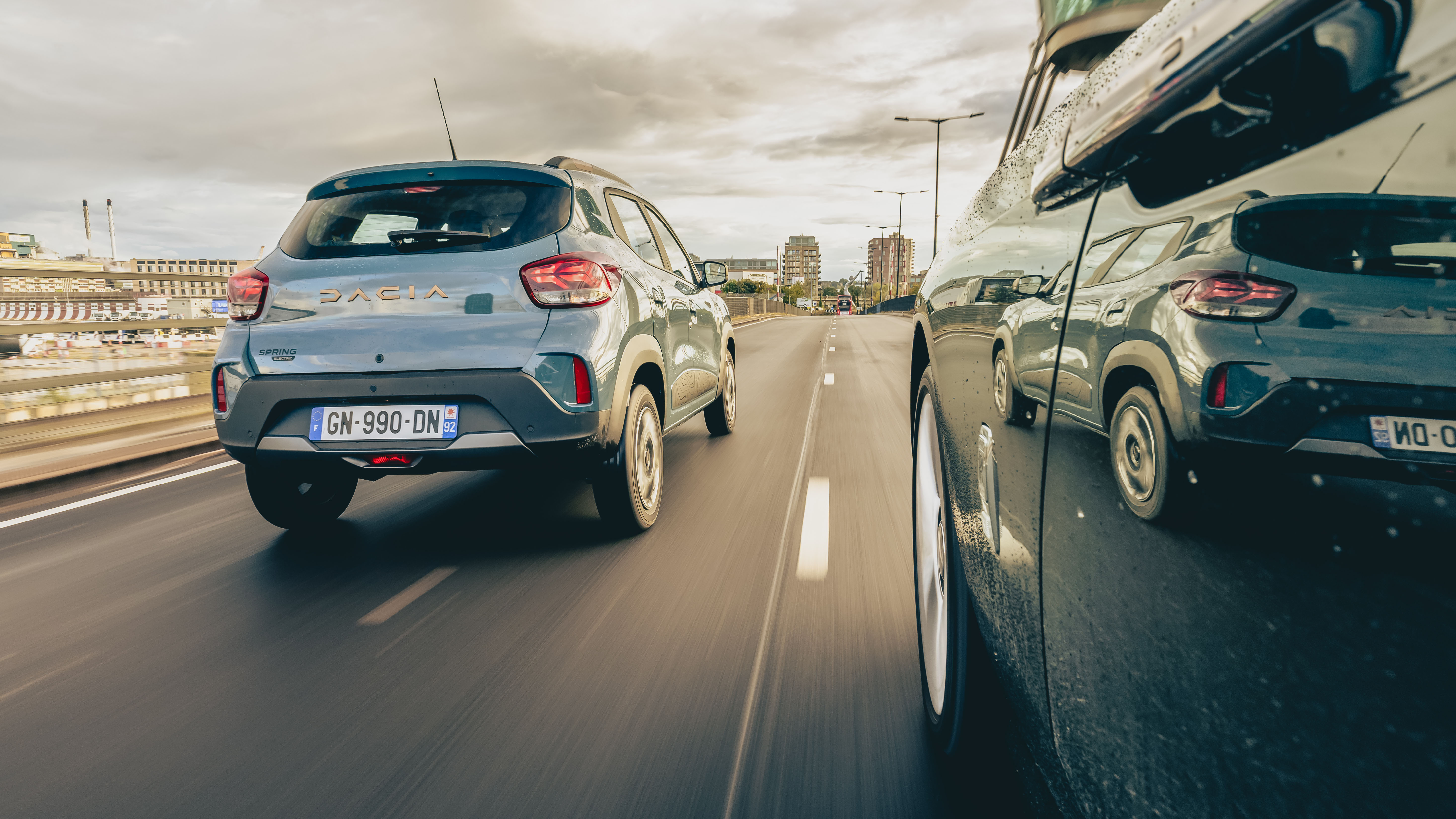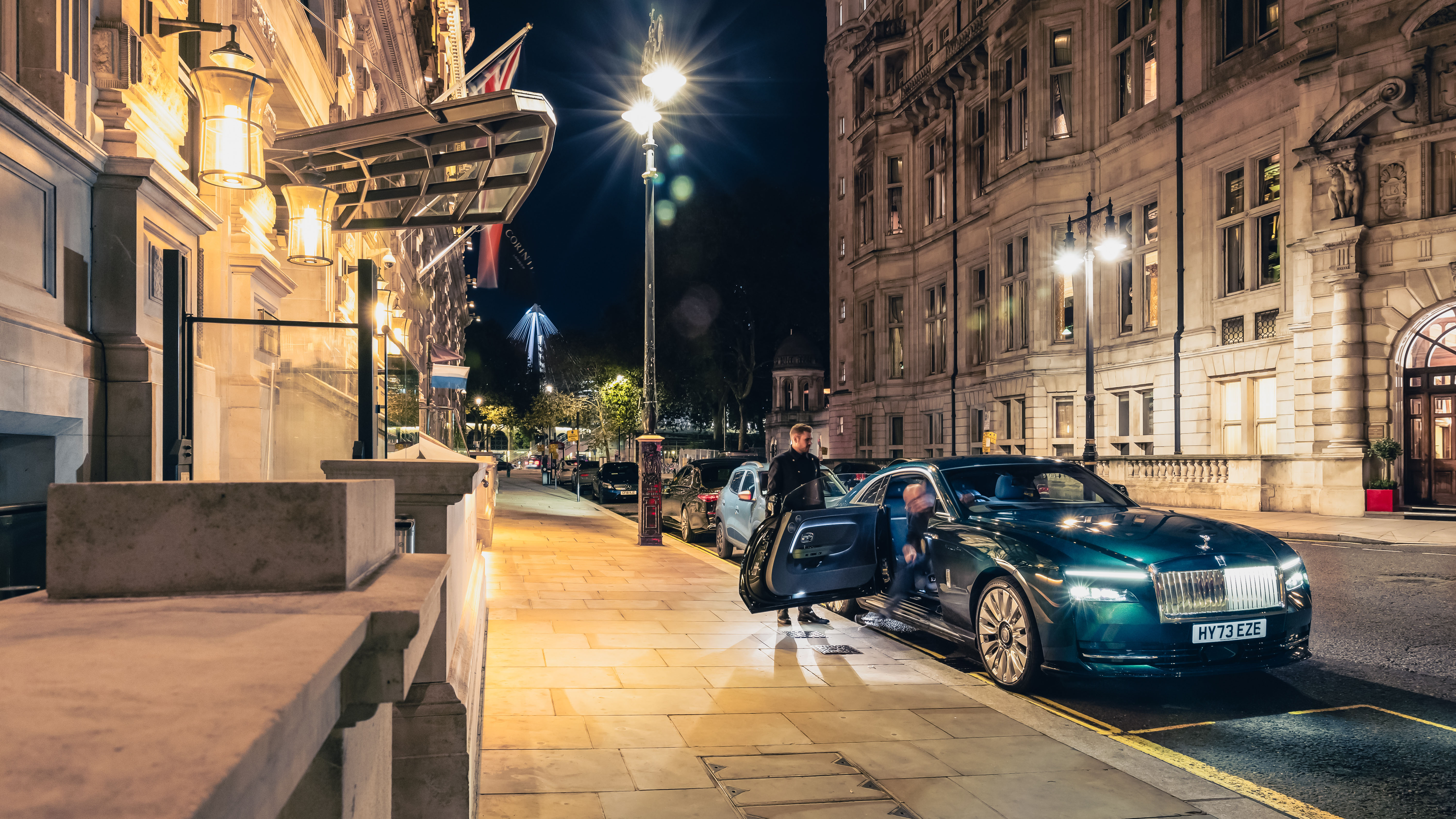
What unites the cheapest EV in the UK (Dacia Spring) and the poshest (Rolls-Royce Spectre)?
There are more parallels between these two TG Award winners than you might think
Don’t laugh. OK, laugh then. A Rolls-Royce beside a Dacia. The most expensive usable electric car against the cheapest. I say usable so as to disqualify the outliers, the electric hypercars and the Citroen Ami. But apart from both acting as respective bookends of the price dimension, they have something else in common. Each, more so than cars in between, is a compelling use for electric power.
Rolls-Royce has spent 117 years perfecting petrol propulsion, culminating in a twin-turbo V12 with an eight-speed auto box that can time its shifts by reading the road ahead via its satnav. This marvel of a powertrain conveys a new Phantom with smoothness and silence that almost matches that in the Dacia’s relative, an 11-year-old Renault Zoe. So electricity is the necessary next step for Rolls-Royce.
Also, Rolls owners won’t worry about their EV’s range. The 240 miles that we got on open roads should do nicely. These people won’t be bothered by the potential hassles of on-trip replenishing (yes, I did spend an hour with it on a 50kW charger just beside Wormwood Scrubs prison). If they want to drive non-stop to the south of France in a Rolls-Royce they’ll just take the Wraith or the Phantom because they have each of those too. If they plan on doing the journey in stages, they can take the Spectre. When they stop for lunch or overnight, the maître d’ or concierge will sort the charging for them. The helpful fellows on the door of the Corinthia Hotel, where we photographed the car, would have been only too delighted.
Photography: Jonny Fleetwood
The Spring is also a perfect fit for electric power, despite its range being even shorter. Its stereotypical owner might be a key worker living in the suburbs but needing to shuttle to work in hospitals or home care in a city where an EV avoids congestion charges and emission based parking fees. It’ll start at £19k odd when it gets to Britain, after a facelift, in summer 2024; those savings will easily equalise the monthly loan cost versus a cheaper to buy petrol Kia Picanto. Even going non-stop for 12 hours in a congested city won’t flatten its battery. And compared with a manual small car, it’s an absolute breeze to drive in traffic.
The Spectre is unbelievably comfortable and quiet in town, although you get the odd anxious moment because of its huge breadth. Out of town, when you use the full driver assist on a dual carriageway, the lane departure bonger goes off all the time because you’re pretty much departing the lane on both sides at once.
Even so, it’s honestly a breathtaking and captivating carriage. The silence isn’t complete. That’d be odd. But I don’t think I’m sticking my neck out to say it’s the quietest car anywhere, not just in the suppression of the wind and tyres and suspension, but in isolating you from nearby vehicles too. It certainly provides a fine stage for the excellent stereo – a system that, rather than sounding like hi-fi, mercifully sounds like music.
The ride is also staggering, if again, not quite perfect: the wheels are so heavy that their vertical momentum can’t quite be quenched over high frequency surface impulses. But I can’t think of a car that coddles you better. The body’s vertical movements are actually quite big: it sighs upwards on a bump, and only gradually returns to normal. But these motions are so gentle, rounded and controlled it’s a super relaxing form of low flight.
Its twin motors can of course slam it forward at near brutal rates, but, and this is harder to engineer, the accelerator is calibrated so you can drive with airy smoothness. The brakes too. The steering has a lovely oily damped quality and a well chosen gentle ratio, and it beautifully matches the take-up of the chassis and tyres, flattering you by easing in and out of bends with nonchalant precision. Adaptive anti-roll systems keep it from rocking on straights but hold it relatively level in corners, yet you never sense the hand-off between those two states. It flows.
This is the kind of serenity you would expect from Rolls-Royce. Less expected is the Spectre’s ability to hustle. It keeps hold of its dignity and composure whether you’re driving like a chauffeur or a hoon. The tyres, on 23in rims, do a Herculean job of containing the torque, and if you hit a damp patch or go over a crest when on a full power corner exit and they finally become overwhelmed, the ESP system is as subtle, and strong, as silk. The damping can cope with some pretty crazy bumps and dips.
Just don’t expect involvement. Usually I want to feel what a car is up to but the Spectre does all this difficult stuff in total discretion. It’s like you’ve asked your assistant to get you front row for Madonna at The O2. They pull every string, bribe every tout, and hand you the tickets. But they never mention the effort. Then you say casually that actually you want the next night instead. They don’t bat an eyelid, but just repeat and oblige.
All of this is, no question, a high water mark for the automobile. But be aware the Rolls demands certain things of the people using it. Look at the doors. Their opening and closing is motorised. Which should be delightful. Except... for them to power open you must keep pulling the interior handle towards you as it, with the door, motors away from you. That’s counterintuitive and hard to reach, so it’s easier to push the ruddy thing yourself. Getting in, the driver’s one inhales itself closed when you touch the brake pedal. Very thoughtful. The passenger’s closes when they manage to find a little switch on the centre console. And when you do get out and stand near the door as it closes, its extravagantly curved leading edge shutline means it’ll likely clout you on the shin. The bootlid is quite light, so has no earthly need to be power operated. But it is, and its motion is painfully slow. To let someone into the back seat, the front seat motors forward, again glacially. Why not a latch to declutch the motors, so you could just shove the seat forward? This overassistance is like arriving in a posh hotel. A porter relieves you of your bag: “I’ll take it to your room, sir.” And you end up in your room ahead of your bag.
Top Gear
Newsletter
Thank you for subscribing to our newsletter. Look out for your regular round-up of news, reviews and offers in your inbox.
Get all the latest news, reviews and exclusives, direct to your inbox.
What I’m saying is luxury demands a mindset: you must be prepared to have things done for you even when it’d be more convenient to do them yourself. I am not wired that way. I felt an imposter in the Spectre. Sorry – it’s not it, it’s me.
I felt right at home in the Spring. I have long experience of Renault 5s and a first-generation Twingo. Their dashboards sound like a sandwich box when you tap them (who except car reviewers taps a dashboard?). Their doors shut with a clang, the central locking makes a hollow click, and when parking I swear I can hear the steering assist motor working. This is absolutely fine by me: it’s honest. It feels and sounds cheap because it is. And it speaks of the light weight – under a tonne – that demonstrates how its resource footprint is minimised. If at the facelift they reskin the dash in soft feel material I’d be mildly outraged because I’d want that money spent instead on better quality suspension bushes.
Because, yes, the Spring is cheap underneath too. But well judged. It bowls cheerfully along. Its ride is actually quite supple and controlled, but you hear thumping noises as it hits a ridge, and the tiny tyres manage to send up as much road roar as the ones in a 911 GT3 (about which few car reviewers ever complain, by the way). The drive motor moves off from rest a little grittily, whereas in the Rolls-Royce you don’t consciously discern the point where stasis melts into motion.
The Dacia’s narrowness turns lanes and alleys into superhighways. It’s delightfully light and agile on town roads. But that lightness translates into a vulnerability to crosswinds at motorway speed. It’ll do 78mph all out. If the 0–62 is slow according to a stopwatch, in your perception it’s quicker than the Spectre’s rear seat access. The Spring’s meagre power is about right because it matches the frailty of tyre grip. Steering and brakes react proportionally to your inputs, so it’s carefree fun. Drive as fast as you like; you won’t break any speed limits.
To be clear, the test car will be about £21,000 plus £500-ish for a DC charge input that’s unavailable on the £19k car, although it’s only 30kW DC so on a motorway trip you’ll be an hour charging for every hour driving. Also, the upper spec of Spring gets the 65bhp motor. The cheaper one has 45bhp and barely cracks 20 seconds for 0–62mph.
The Dacia’s interior is simple, understandable. A CarPlay screen is optional and I expect people will just clamp their phone to the dash as it has USB and aux-in for audio. The seat and wheel don’t height adjust, but you won’t be sitting there for long. The back seat is tight, the boot OK for nipping around. If you go far with three adult passengers and luggage, you stand to be hated by them. Auto emergency braking and six airbags are there, because they’re mandatory now. The standard fitment of aircon looks like an acknowledgement of climate change.
Heating and ventilation are controlled by actual knobs. Another thing in common with the Spectre, then. The Rolls-Royce has a control panel for climate deliberately reminiscent of the one they introduced in the Silver Shadow II in 1977. Why mess with perfection? The air vents and lighting controls are equally traditional and you just want to caress them.
Fortunately you can also programme any of the eight unlabelled chrome buttons below the vents to turn off the lane assist rather than go menu diving. You could also ask the voice assistant, but that’s embarrassing if you’re not alone and this is emphatically a car to share. The seats are lovely loungers, trimmed with craft and extravagance. Your peripheral vision tingles with the chromed highlights and LEDs. As a coupe of course it’s irrational, combining a slight miserliness of space with an extreme generosity of spirit. The low roof – the only lowbrow thing about the Spectre – makes it feel snug and rear legroom is only OK.
If owners need more in the back, the dust cover comes off their four-door Rolls. If they want to go further, same deal: they’ll use another car. Both the Spring and the Spectre are so brilliant because they simply aren’t aiming for do it all long distance spacious practicality. They’re specialists. For the Spring it’s about marvellous ease of city driving and parking, and ultra low cost of ownership. For the Spectre, it’s about silence, smoothness and comportment. Electric drive is critical to both...





